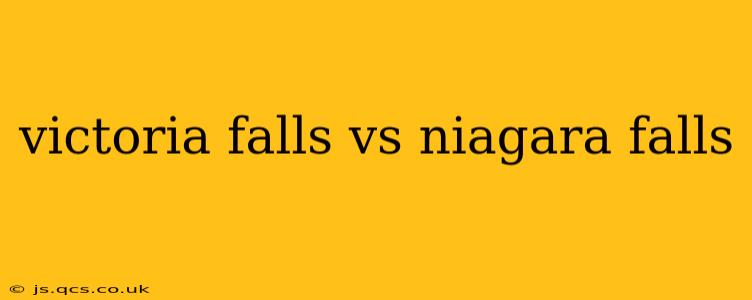Victoria Falls and Niagara Falls, two of the world's most iconic waterfalls, captivate visitors with their raw power and breathtaking beauty. While both offer incredible sightseeing experiences, they differ significantly in scale, setting, and overall atmosphere. This comparison will delve into the key distinctions, helping you decide which majestic spectacle best suits your travel aspirations.
What Makes Victoria Falls Unique?
Victoria Falls, located on the Zambezi River bordering Zambia and Zimbabwe, is renowned for its sheer scale and raw power. It's often called "the smoke that thunders," a fitting description for the immense spray that perpetually rises from the chasm. Unlike Niagara, Victoria Falls boasts a much wider curtain of water plunging into a dramatic gorge, creating a truly awe-inspiring spectacle. The surrounding rainforest adds a lush, vibrant backdrop, enhancing the immersive experience.
How Wide is Victoria Falls?
Victoria Falls boasts a breathtaking width of approximately 1,708 meters (5,604 feet), significantly wider than Niagara Falls. This immense width contributes to its sheer power and dramatic appearance. The water plunges into a narrow gorge, creating a dramatic, almost overwhelming sense of scale.
What is the Best Time to Visit Victoria Falls?
The best time to visit Victoria Falls is during the dry season (May to October) when the water flow is lower, offering clearer views and a more manageable spray. However, the wet season (November to April) provides a dramatic display of the falls' immense power, with higher water volumes and a more powerful roar. The choice ultimately depends on your preference for viewing conditions.
Niagara Falls: A Different Kind of Majesty
Niagara Falls, situated on the Niagara River between the United States and Canada, presents a distinct charm. While not as wide as Victoria Falls, its three distinct waterfalls—Horseshoe Falls, American Falls, and Bridal Veil Falls—offer a diverse landscape. The proximity of the falls to developed areas allows for easier access and a wider range of tourist activities, from boat tours to observation towers.
What Makes Niagara Falls Unique?
Niagara Falls' unique charm lies in its accessibility and the variety of ways to experience its majesty. Visitors can take boat tours right to the base of the falls (Maid of the Mist), ascend observation towers for panoramic views, or explore the surrounding parks and attractions. The falls' proximity to major cities provides a convenient and readily accessible travel destination.
How High are Niagara Falls?
The Horseshoe Falls, the largest of the three Niagara Falls, stands at a height of approximately 51 meters (167 feet). This height, combined with its width, creates a powerful and impressive spectacle. The overall height of the Niagara Falls varies slightly depending on which section is measured.
Victoria Falls vs Niagara Falls: A Head-to-Head Comparison
| Feature | Victoria Falls | Niagara Falls |
|---|---|---|
| Width | 1,708 meters (5,604 feet) | ~671 meters (2,200 feet) |
| Height | ~108 meters (354 feet) | ~51 meters (167 feet) (Horseshoe) |
| Setting | Lush rainforest | Developed urban environment |
| Accessibility | More remote, requires more travel | Easily accessible from major cities |
| Activities | Hiking, wildlife viewing, rafting | Boat tours, observation towers, city exploration |
| Overall Vibe | Wild, untamed, powerful | More tourist-friendly, well-developed |
Which Falls Should You Visit?
The choice between Victoria Falls and Niagara Falls depends entirely on your preferences. If you crave a raw, untamed natural experience surrounded by breathtaking wilderness, Victoria Falls is the clear winner. If you prefer a more accessible, tourist-friendly destination with a wider range of activities and easier logistics, Niagara Falls might be a better fit. Both offer unforgettable experiences; the "better" one is subjective and depends on your travel style and priorities.
